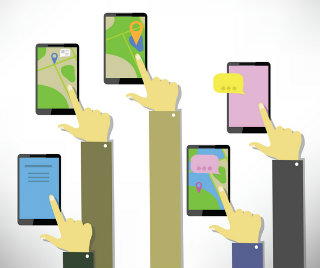Don’t Let Class Tech Be Just a Garnish

During my college years, I worked as a server at several restaurants to pay my rent. At the swankiest of these, I recall the chef once telling his sous chefs to take their time plating neatly and to remember the garnish. He was fond of saying, “Do you know the difference between a ten-dollar dinner and a fifteen? Parsley.”
In the current educational climate, where any lesson that utilizes technology is considered superior, I can’t help but notice that a lot of what is being done is just adding parsley.

The limits of “cool”
Exposed to decades of modern education research, teachers are well aware of best practices. We know that modern classrooms should incorporate 21st century skills, be student-centered and brain-based, strive to reach all learners, and provide authentic learning opportunities. My fear stems from what I have observed happening in the last several years.
Whereas during the NCLB years instruction was driven by what was on the state test (much of it rote learning), now curriculum is influenced heavily by what app we want to use just because it’s “cool.” The problem with this thinking is that cool fades—learning sticks. No one ever fondly recalls the delicious taste of the garnish.

They are more concerned with the trimmings than the entrée. Teachers need to determine what is to be taught before they decide what technology to use. The task at hand should influence the choice of technology and not vice-versa.
It’s been said before, but it bears repeating, that technology, whether in the form of a device or an application, is but a tool in our teaching toolbox. It needs to be an integral and vital part of the lesson, and must truly improve the instruction.
You want students to be able to answer the question, “What are you learning?” and not, “What are you playing with?”
New fangled drill-and-kill
Another issue is that a great deal of the incorporation of technology occurs at the most superficial level and only serves to replace current practice rather than improve upon it. Teachers should be focusing on what students can do with the addition of technology that they could not do without it before. Too many apps are just animated drill-and-kill exercises.
While some rote memorization is necessary in school, especially as one is developing the foundation for more advanced skills, if the only thing you do is replace one monotonous practice with another, you are not getting much bang for your technology buck. Research shows that focusing solely on rote tasks does not promote understanding or long-term retention of information. A digital worksheet is still just a worksheet.

“Sit and get” at home is not better than “sit and get” in class. We know that active rather than passive learning is a worthy goal. It is imperative to keep in mind that teaching should be brain based, not screen based. We know that too much screen time can lead to isolation, when what we should be encouraging is collaboration and higher-order thinking. Screens should only be an addition to our lessons if they are truly enhancing students’ learning.
Why tech motivation is extrinsic
Good middle school teachers strive to keep their students engaged and productive. They want to make the best use of their precious few minutes of time with the kids. However, using technology for the sole purpose of increasing engagement is a very short-sighted goal. Alfie Kohn and Daniel Pink have devoted considerable effort to sharing the science of what motivates us. If we’ve paid attention, we know that by focusing only on engagement without purpose, we will never achieve true mastery of content.
Being engaged with the fun aspect of technology is a form of extrinsic motivation, and outside rewards do not lead to internal desire to learn material. Educators must not trade a true wish to make meaning of information for a short-term distraction to keep students occupied.

As the saying goes, we are preparing students for jobs that don’t yet exist, and so we need to prioritize the 21st century skills of creativity, collaboration, communication, and critical thinking.
Our classrooms need to be student-centered and incorporate authentic learning tasks. We don’t need to make the same old entrée look better; we need to reinvent it or prepare it in a completely new and improved way.
1:1 equals student to teacher
Students need to reflect on what they are learning, be able to demonstrate it in myriad ways, and share what they have learned with others. All of this will never happen by just swiping a screen.
Critical thinking requires significant mental effort, but this is the only way we can make meaning of the tremendous amount of information available at our fingertips. Students must have a sincere motivation to master the material, and that begins with relationships to the teacher and purposeful action, not just deciding which app they get to play at school today.

I’m not saying don’t use technology. Please use it! But incorporate it mindfully and purposefully in order to reap all the potential benefits. Try to make sure your dinner is truly worth $15 and not just the same old $10 dish with a pretty, yet unmemorable, throwaway.
Cheryl Mizerny (@cherylteaches) is a veteran educator with 20+ years experience–most at the middle school level. She began her career in special education, became a teacher consultant and adjunct professor of Educational Psychology, and currently teaches 6th grade English in Bloomfield Hills, Michigan. Cheryl writes about student motivation and engagement at The Accidental English Teacher and is a regular contributor to the SmartBrief SmartBlog on Education. Read more of her MiddleWeb articles here.


































